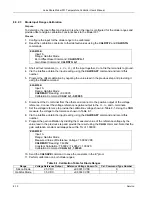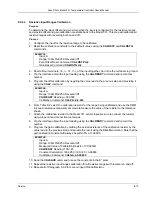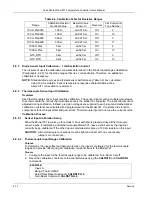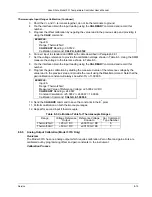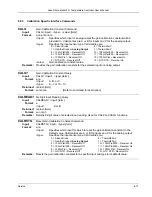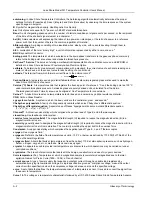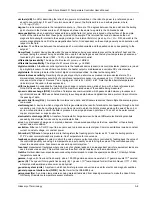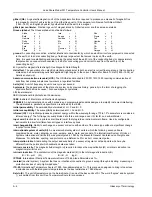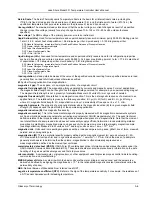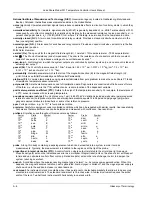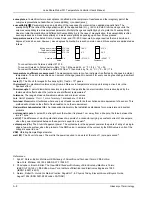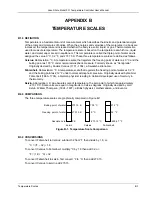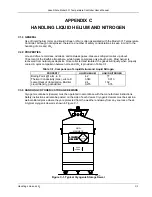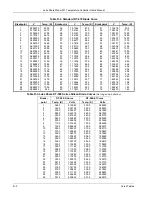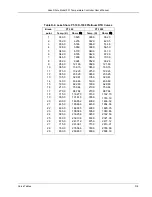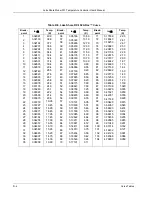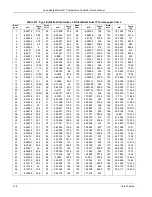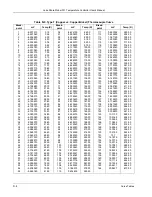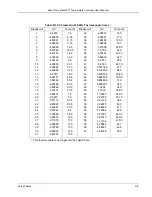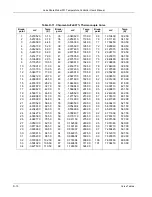
Lake Shore Model 331 Temperature Controller User’s Manual
susceptance
. In electrical terms, susceptance is defined as the reciprocal of reactance and the imaginary part of the
complex representation of admittance: [suscept(ibility) + (conduct)ance].
susceptibility (
χ
)
. Parameter giving an indication of the response of a material to an applied magnetic field. The
susceptibility is the ratio of the magnetization (M) to the applied field (H).
χ
= M/H. In both SI units and cgs units the
volume susceptibility is a dimensionless parameter. Multiply the cgs susceptibility by 4
π
to yield the SI susceptibility.
See
also Initial Susceptibility and Differential Susceptibility. As in the case of magnetization, the susceptibility is often
seen expressed as a mass susceptibility or a molar susceptibility depending upon how M is expressed.
temperature scales
.
See
Kelvin Scale, Celsius Scale, and ITS-90. Proper metric usage requires that only kelvin and
degrees Celsius be used. However, since degrees Fahrenheit is in such common use, all three scales are delineated as
follows:
Boiling point of water
Freezing point of water
Absolute zero
kelvin
Celsius
Fahrenheit
0 K
273.15 K
373.15 K
–273.15 °C
0 °C
100 °C
–459.67 °F
32 °F
212 °F
Triple point of water
273.16 K
To convert kelvin to Celsius, subtract 273.15.
To convert Celsius to Fahrenheit: multiply °C by 1.8 then add 32, or: °F = (1.8 × °C) + 32.
To convert Fahrenheit to Celsius: subtract 32 from °F then divide by 1.8, or: °C = (°F – 32 ) / 1.8.
temperature coefficient, measurement
. The measurement accuracy of an instrument is affected by changes in ambient
temperature. The error is specified as an amount of change (usually in percent) for every one degree change in ambient
temperature.
tesla (T)
. The SI unit for magnetic flux density (B). 1 tesla = 10
4
gauss
thermal emf
. An electromotive force arising from a difference in temperature at two points along a circuit, as in the
Seebeck effect.
1
thermocouple
. A pair of dissimilar conductors so joined at two points that an electromotive force is developed by the
thermoelectric effects when the junctions are at different temperatures.
2
tolerance
. The range between allowable maximum and minimum values.
torr
. Unit of pressure. 1 torr
≈
1 mm of mercury. 1 atmosphere = 760 torr.
two-lead
. Measurement technique where one pair of leads is used for both excitation and measurement of a sensor. This
method will not reduce the effect of lead resistance on the measurement.
Underwriters Laboratories (UL)
. An independent laboratory that establishes standards for commercial and industrial
products.
unit magnetic pole
. A pole with a strength such that when it is placed 1 cm away from a like pole, the force between the
two is 1 dyne.
volt (V)
. The difference of electric potential between two points of a conductor carrying a constant current of one ampere,
when the power dissipated between these points is equal to one watt.
2
volt-ampere (VA)
. The SI unit of apparent power. The volt-ampere is the apparent power at the points of entry of a single-
phase, two-wire system when the product of the RMS value in amperes of the current by the RMS value in volts of the
voltage is equal to one.
2
VSM
. Vibrating Sample Magnetometer.
watt (W)
. The SI unit of power. The watt is the power required to do work at the rate of 1 joule per second.
2
References:
1 Sybil P. Parker, Editor.
McGraw-Hill Dictionary of Scientific and Technical Terms: Fifth Edition
.
New York: McGraw Hill, 1994 (IBSN 0-07-113584-7)
2 Christopher J. Booth, Editor.
The New IEEE Standard Dictionary of Electrical and Electronic Terms:
IEEE Std 100-1992, Fifth Edition.
New York: Institute of Electrical and Electronics Engineers, 1993
(IBSN 1-55937-240-0)
3 Nelson, Robert A.
Guide For Metric Practice,
Page BG7 - 8, Physics Today, Eleventh Annual Buyer’s Guide,
August 1994 (ISSN 0031-9228 coden PHTOAD)
A-8
Glossary of Terminology

